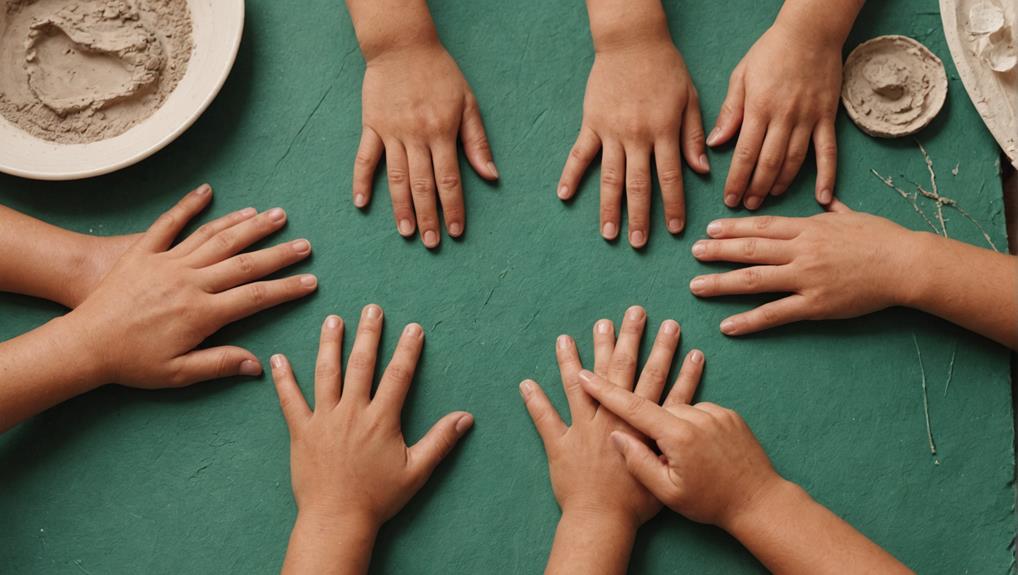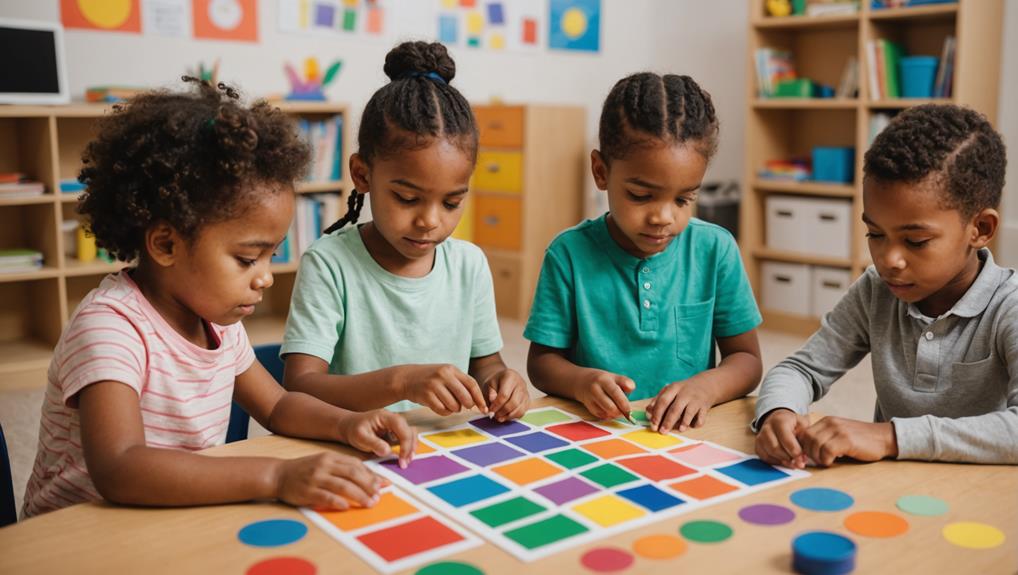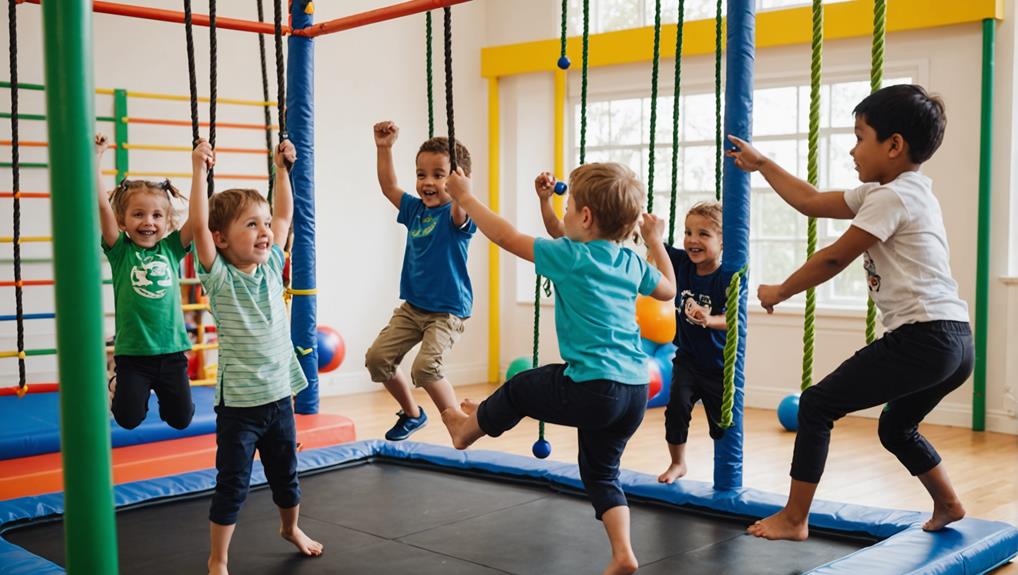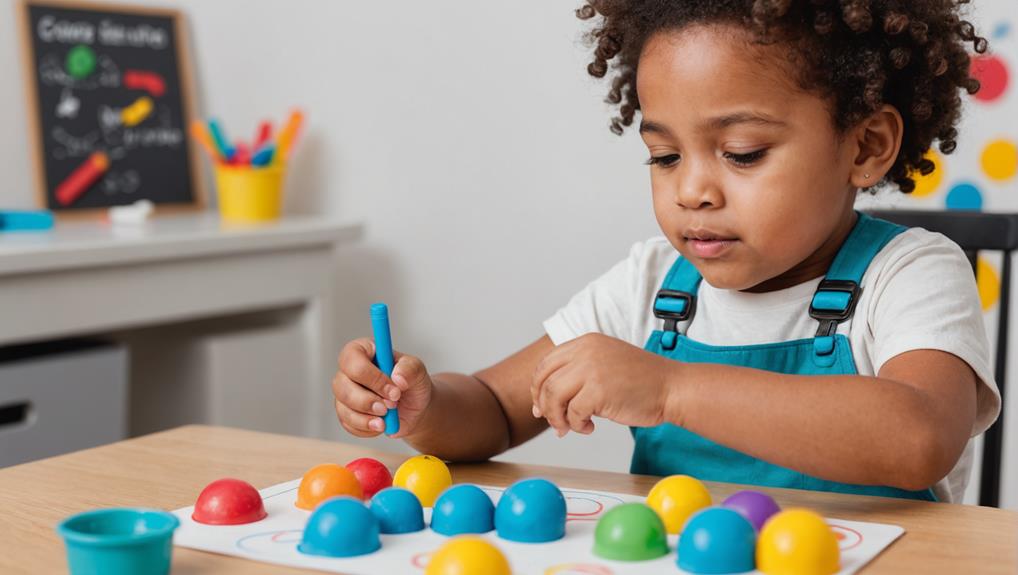Key Takeaways
- Incorporate tactile sensory activities like sensory bins and playdough to induce relaxation and improve emotional regulation.
- Use auditory activities such as calming music and nature sounds to create a soothing environment and enhance sensory integration.
- Engage children in visual activities like coloring and drawing to reduce anxiety and provide a medium for non-verbal expression.
- Introduce olfactory activities such as aromatherapy with calming scents like lavender and chamomile to stimulate positive memories and support healing.
- Implement gustatory activities, such as tasting different snacks, to create positive associations, distract from stressors, and promote emotional stability.
Understanding Childhood Trauma
While childhood is often idealized as a carefree period of life, it is essential to acknowledge that for many children, it can involve experiences that profoundly overwhelm their ability to cope, leading to lasting impactful and psychological effects. This is what we define as childhood trauma. Such experiences can range from abuse, neglect, violence, and accidents to natural disasters.
The manifestation of such trauma can vary extensively among children. Some common symptoms include anxiety, depression, aggression, withdrawal, and difficulties in forming and maintaining relationships. Children who have experienced trauma may also display signs of sensory processing difficulties, similar to those seen in Sensory Processing Disorder, which can further complicate their ability to regulate emotions and interact successfully in social settings.
Childhood trauma not only affects a child’s emotional state but can also have significant consequences on their neurological development. This can lead to emotional regulation, behavior, and cognitive functioning challenges. As service providers in the field of childcare, understanding the effects of trauma on children is essential.
This knowledge guides us in providing appropriate support and interventions, such as sensory activities, to promote healing and recovery. These activities play a significant role in reducing stress and helping children regain control over their emotional regulation. Our primary goal is to foster an environment where children can flourish despite adversity.
Importance of Sensory Play
Recognizing the profound effects of trauma on children allows us to see the value of sensory play in their healing and recovery process. As an engaging method that incorporates all senses—touch, hearing, sight, taste, and smell—sensory play fosters holistic development and mental regulation, providing a comforting platform for children to regain control over their surroundings.
Children who have experienced trauma may develop hypersensitivity to stimuli and face challenges in filtering sensory information. This can affect their sensory processing, leading to discomfort and distress. Sensory play can mitigate these effects by encouraging exploration and problem-solving in a safe environment, helping children adapt to sensory stimuli at their own pace.
Incorporating sensory integration techniques in sensory play can tailor the experience based on each child’s specific needs, thereby enhancing the effectiveness of this therapeutic approach.
Moreover, sensory play aids in recovering developmental skills that traumatic experiences may have hindered. It provides a therapeutic pathway for children to navigate their past trauma, building resilience and promoting healing. In this way, the importance of sensory play cannot be underestimated in helping children recover post-trauma, supporting their mental well-being and a healthy sensory processing system.
Tactile Sensory Activities

Tactile sensory activities play an essential role in alleviating stress in children. They harness the power of touch to induce relaxation and sensory investigation. These activities can be especially advantageous for children with Sensory Processing Disorders, which can result in oversensitivity and coordination challenges. Engaging the sense of touch allows children to interact with various textures and materials, promoting an immersive, calming experience, particularly after traumatic experiences.
Tactile tools like sensory bins and playdough offer entertainment and engagement and function as therapeutic interventions, calming the child’s nervous system and reducing stress levels. By manipulating these materials, children can investigate their world, express their creativity, and, importantly, regain a sense of control often lost during traumatic events.
Furthermore, integrating tactile sensory activities into daily routines can improve emotional regulation. Regular exposure to these activities allows children to familiarize themselves with different sensory experiences, fostering adaptive responses to stressors. Consequently, children can better manage their emotions, reducing anxiety and promoting resilience.
Auditory Sensory Activities
Moving from the tactile to the auditory realm, another set of sensory activities can be pivotal in reducing stress in children. Auditory sensory activities, such as calming music, nature sounds, or guided meditations, can cultivate a soothing auditory environment that fosters relaxation. Trauma can impact a child’s ability to regulate emotions and focus, areas in which research suggests that auditory sensory input can offer significant assistance.
Incorporating auditory elements like storytelling, audiobooks, or soundscapes into daily routines can provide comfort, distraction, and a sense of normalcy for children coping with trauma. This is especially beneficial for children experiencing Sensory Processing Disorder, as these activities can also aid in regulating sensory responses and enhancing sensory integration. The familiarity of these sounds can create a predictable auditory environment, which is essential in calming children and promoting a sense of security post-trauma.
Auditory sensory activities are not just about passive listening; they also encourage active engagement and exploration of sounds. This interaction can help children feel in control and safe, which are critical elements in the healing process. Essentially, these activities can serve as powerful tools in assisting children in navigating and recovering from traumatic experiences, restoring their sense of safety and well-being.

Focusing on visual sensory activities, it’s essential to understand their role in managing conditions like Sensory Processing Disorder. These actions, such as coloring, drawing, and exploring light boxes, engage the visual sense and aid in sensory integration, an essential aspect of pediatric occupational therapy strategies. Shadow puppet play is another distinct and engaging method that allows children to express their emotions through creative imagery. The use of these visual tools can significantly aid in reducing anxiety, regulating emotions, and providing a sense of peace in the aftermath of traumatic events.
Coloring and Drawing Calm
Coloring and drawing are potent tools in visual sensory activities that promote relaxation and self-expression in children, especially after exposure to traumatic events. These creative outlets engage the visual senses, allowing children to process and communicate their feelings nonverbally. Focusing their attention on the task at hand notably reduces stress and anxiety.
- Emotion Regulation: Drawing calm scenes or patterns can soothe the nervous system, helping children regulate their emotions after a traumatic event. The repetitive motion of coloring can also induce a state of calm, assisting in emotional steadiness.
- Self-Expression: Coloring and drawing provide children with a medium for expressing their emotions without needing words. This can be especially beneficial for children who struggle to verbalize their feelings.
- Engaging Visual Senses: These activities help children focus by engaging their visual senses, distracting them from their traumatic experiences, and offering moments of peace and solace.
As advocates for child well-being and wellbeing, utilize these activities to gently guide children in coping with trauma, creating a safe space for them to express, heal, and find comfort.
Exploring Light Boxes
Exploring the world of sensory tools, light boxes emerge as a promising avenue for mitigating stress in children. These pivotal sensory tools provide calming visual stimulation through colored lights and patterns, aiding in regulating emotions post-trauma. Light boxes can be seamlessly integrated into sensory rooms, therapeutic interventions, or even at home, creating a soothing environment for children to unwind.
The gentle, flickering lights of a light box can reduce children’s trauma, stress, and anxiety. As a noninvasive therapeutic intervention, light boxes offer a tranquil, comfortable space for children to engage with their senses, helping them process traumatic events non-threateningly.
| Use Case | Benefits |
|---|---|
| Sensory Rooms | Creates a calming, immersive environment |
| Therapy Sessions | Complements traditional therapeutic interventions |
| At Home | Offers a soothing space within a familiar environment |
Shadow Puppet Play
Following the illuminating insights on light boxes, we now shine a light on another sensory activity that holds immense potential for reducing stress in children – Shadow Puppet Play. This engaging and creative approach to visual sensory stimulation can be a comforting and calming activity for children dealing with inner turmoil.
Shadow puppet play allows children to express their feelings and experiences nonverbally, creating a safe space to process their emotions. This activity also encourages focus and concentration, giving children a sense of control and strength, which can be therapeutic in the aftermath of challenging events.
Here are three reasons why shadow puppet play is an excellent tool for stress reduction:
- Creativity and Imagination: This activity encourages children to create their characters and stories, stimulating their creativity and imaginative skills.
- Emotional Expression: A non-verbal medium for children to express their feelings facilitates emotional processing and healing.
- Focus and Strength: Enhances children’s focus and gives them a sense of control, which can be empowering.
Versatile and portable, this sensory activity fosters connection and communication, whether enjoyed alone or with others.
Olfactory Sensory Activities
Olfactory sensory activities engage the sense of smell and are practical tools for alleviating stress in children who have undergone distressing events. The power of smell can profoundly impact a child’s mental state, as certain scents, like lavender, chamomile, and vanilla, are known for their calming effects. This makes olfactory sensory activities a crucial part of trauma recovery strategies.
Aromatherapy, using vital oils, can help create a calming environment for children post-trauma. By integrating these scents into the child’s surroundings, we can stimulate their olfactory senses, which can trigger positive memories and feelings, assisting in relaxation and stress reduction. This confirms the potency of the olfactory system in affecting our mental well-being.
Weld-being sensory activities like playing with scented playdough, lighting scented candles, or applying scented lotions can expose children to calming scents, further enhancing the therapeutic benefits. These olfactory sensory activities can offer a gentle and non-intrusive way to support children through their healing by providing a comforting and familiar sensory experience.
Gustatory Sensory Activities

While it may seem unconventional, taste-focused sensory activities centered around the sense of taste serve as an effective strategy in alleviating stress among children who have experienced trauma. These activities encourage children to explore diverse flavors and textures, providing a calming and distracting sensory experience that can significantly assist in emotional regulation and relaxation.
- Assortment of snacks: Providing a variety of snacks with unique flavors can create an exciting diversion. This distracts children from their stressors and fosters a positive association with the activity, enriching their comfort and receptiveness.
- Experiment with flavors: Tangy, sweet, savory, and spicy tastes offer a multisensory experience that can be both stimulating and comforting. Exploring different taste sensations can serve as a stress relief tool, helping children divert their attention away from their worries.
- Regular Integration: Integrating taste-focused sensory activities into a child’s routine can reinforce regularity and predictability, which are fundamental for children recovering from trauma. Consistent exposure to these activities can amplify their therapeutic effect, promoting relaxation and emotional stability.
Integrating taste-focused sensory activities into a child’s routine can significantly reduce stress and promote recovery after traumatic experiences.
Vestibular Sensory Activities
Vestibular sensory activities offer a different and practical approach to stress reduction for children. These activities involve movement and balance, targeting the vestibular system in the inner ear, a pivotal component in emotional regulation. After traumatic events, children can often feel overwhelmed and unstable. Vestibular sensory activities provide a sense of security, helping to calm the nervous system and improve focus.
Incorporating vestibular sensory activities into a child’s routine regularly can aid in emotional self-regulation and provide comfort and stability. These activities range from swinging, spinning, jumping on a trampoline, and rocking back and forth. Each activity has distinct benefits and can be chosen based on the child’s comfort and preference.
| Vestibular Sensory Activity | Benefit |
|---|---|
| Swinging | Calms nervous system |
| Spinning | Improves focus |
| Jumping on a trampoline | Promotes emotional regulation |
| Rocking back and forth | It provides a sense of security |
Proprioceptive Sensory Activities

Proprioceptive sensory activities help children understand their body’s position and movement and can significantly reduce stress. One powerful tool is the weighted blanket, which provides deep, calming, and grounding pressure. Moreover, outdoor activities that involve pushing, pulling, or jumping can offer a fun and effective means of regulation.
Weighted Blanket Benefits
Using a simple tool such as a weighted blanket can yield notable benefits in managing stress in children, especially in proprioceptive sensory activities. These blankets, filled with plastic pellets or glass beads, provide deep pressure touch stimulation, a therapeutic technique that helps kids feel grounded and calm after traumatic events.
This calming effect is mainly due to a three-fold biochemical response triggered by the deep-pressure touch stimulation provided by weighted blankets:
- Serotonin and Melatonin Enhancement: Research suggests that weighted blankets can increase serotonin levels, a promo-promoting hormone, and melatonin promotes relaxation and better sleep.
- Oxytocin Release: The pressure from a weighted blanket can stimulate the release of oxytocin, sometimes called the “love hormone,” fostering feelings of safety and security.
- Nervous System Regulation: Proprioceptive sensory activities, like using a weighted blanket, can help regulate the nervous system, promoting a sense of calmness and reducing anxiety.
Incorporating weighted blankets into a child’s routine can notably aid in stress management and stability following trauma.
Outdoor Play and Regulation
Engaging children in outdoor play can offer significant benefits in stress reduction, specifically through the lens of proprioceptive sensory activities. Outdoor play, encompassing climbing, jumping, and running, releases excess energy and engages the proprioceptive sense. This interaction promotes body awareness and regulation, which is crucial in alleviating stress and fostering regulation after traumatic events.
Proprioceptive activities, such as swinging and climbing, provide deep pressure input, a sensory experience that aids in calming and self-regulation. Pushing heavy objects, another effective proprioceptive activity, similarly delivers this helpful input. These activities stimulate the body’s awareness of movement and position, contributing to a sense of grounding and stability, which are fundamental for children coping with trauma.
Incorporating outdoor play with proprioceptive input can be a powerful tool for healing, helping kids feel more in control, calm, and connected to their bodies post-trauma. By blending the fun of outdoor play with the therapeutic benefits of proprioceptive activities, we can foster resilience and recovery in children who have experienced traumatic events.
Combining Sensory Activities
Fostering a multisensory approach, the combination of sensory activities serves as a potent tool in reducing stress among children, particularly those who have experienced trauma. By engaging multiple senses concurrently, these combined activities can amplify the benefits of unique sensory techniques, thereby enhancing the overall stress reduction experience.
Consider incorporating these three multisensory combinations to promote relaxation and stress relief in children:
- Deep Breathing and Tactile Stimulation: Encourage children to perform deep breathing exercises while engaging in tactile activities. This could involve manipulating soft dough, fidget toys, or feeling the texture of a weighted blanket.
- Calming Music and Weighted Blankets: Pair sensory tools like weighted blankets with calming music. This amalgamation can create a soothing environment that helps children unwind.
- Aromatherapy and Mindfulness Techniques: Merge the comforting scents of aromatherapy with mindfulness techniques like visual imagery or progressive muscle relaxation. This integration can help children focus on the present, further promoting relaxation.
Monitoring Progress and Adjusting Activities

As we involve children in sensory activities to reduce stress, it is crucial to monitor their progress, noting developmental changes and responses. This ongoing evaluation guarantees that the child’s needs are met and guides us in adjusting or customizing the stress-reduction techniques. Doing so can create a more individualized approach that improves emotional regulation, effectively reducing stress.
Tracking Developmental Changes
Monitoring developmental changes closely becomes vital to enhancing the effectiveness of sensory activities in reducing stress among children. This involves tracking progress in sensory regulation skills post-trauma and observing improvements in self-control and emotional coping as indicators of positive developmental changes.
Understanding these changes helps personalize sensory interventions effectively, ensuring they align with the child’s evolving needs and abilities. One way to achieve this is by identifying sensory cues and reactions, which aids in tailoring sensory activities for stress reduction. Moreover, regular assessments provide valuable feedback from children, assisting in fine-tuning sensory strategies for ideal stress relief.
Here are some crucial steps to track developmental changes:
- Monitor progress in sensory regulation skills and observe improvements in self-control and emotional coping.
- Identify sensory cues and reactions to personalize sensory activities appropriately.
- Regular assessments should be conducted to gather feedback from children and adjust the sensory strategies effectively.
Modifying Stress-Reduction Techniques
The path toward reducing stress in children requires careful progress monitoring and timely adjustments in sensory activities. This is especially important after traumatic events when children’s emotional landscapes can be uncertain and intricate. Observing changes in stress levels and emotional responses allows caregivers to assess the effectiveness of the sensory activities.
Adaptations to these activities are essential as they allow for a more precise customization of sensory interventions. The goal is to develop a tailored, efficient, effective stress reduction strategy for each child. This approach honors each child’s distinct experiences and reactions to traumatic events and recognizes the uniqueness of their healing process.
Feedback and observation are crucial in this process. Caregivers should be attentive to the child’s reactions, making necessary adjustments to the sensory activities to address specific needs. This fosters a supportive atmosphere for healing and emotional regulation, enabling caregivers to refine interventions for improved outcomes post-trauma. The ultimate objective is to use sensory activities to reduce stress, promoting children’s resilience and recovery after traumatic events.
Frequently Asked Questions
What Are Sensory Interventions for Trauma?
Sensory interventions for trauma involve therapeutic activities that engage the senses, such as touch, sight, sound, smell, and taste, to regulate emotions, reduce stress, and address sensory difficulties in children’s post-traumatic events.
How Do You Treat Post Traumatic Stress in Children?
Treating post-traumatic stress in children often involves trauma-focused cognitive behavioral therapy, eye movement desensitization and reprocessing, play therapy, parent-child interaction therapy, and mindfulness-based interventions. The goal is to manage symptoms and enhance the overall state of health.
How to Help Children Recover From Trauma?
Helping children recover from trauma involves creating a stable, supportive environment, encouraging expression of feelings, consistency in routines, and seeking professional mental health support. Implementing sensory activities can also aid in managing stress and regulation of emotions.
What Are Calming Strategies for Children With Trauma?
Calming strategies for children with trauma involve sensory regulation methods such as weighted blankets, fidget toys, dancing, gardening, deep breathing exercises, progressive muscle relaxation, mindful body scanning, routine establishment, and predictability.
Conclusion
Essentially, using sensory activities after traumatic incidents is like providing a lifeboat in a turbulent ocean of feelings for children. These activities, often underestimated, act as potent tools in promoting emotional healing and strength. Caregivers must customize these sensory experiences to each child’s needs, consistently monitor progress, and adjust as necessary. Through this method, we can guarantee the creation of a safe, healing environment, nurturing the emotional wellness of children after trauma.


Recent Comments